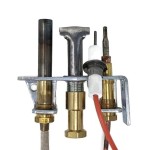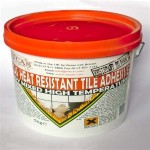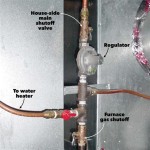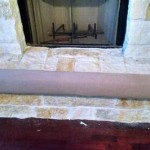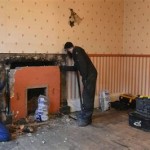```html
Corner Gas Fireplace Hearth: Design, Functionality, and Installation
A corner gas fireplace hearth serves as a crucial element in both the aesthetic appeal and functional safety of a corner-mounted gas fireplace. The hearth, traditionally a non-combustible platform extending from the fireplace opening, protects combustible flooring and surrounding walls from the intense heat radiated by the fire. In the context of a corner gas fireplace, the hearth design often presents unique opportunities for creative expression and optimized space utilization, requiring careful consideration of dimensions, materials, and installation techniques.
Gas fireplaces, unlike their wood-burning counterparts, offer the convenience of instant ignition and consistent heat output. However, they still generate significant heat, particularly radiant heat, necessitating a properly constructed hearth. The hearth acts as a thermal barrier, preventing the ignition of carpets, wood floors, or other flammable materials located near the fireplace. Furthermore, it provides a designated space for tending to the fireplace and can serve as a visual anchor, enhancing the overall design of the room.
Meeting Safety Regulations and Building Codes
Compliance with local building codes and safety regulations is paramount when constructing a corner gas fireplace hearth. These regulations typically specify minimum hearth dimensions, material requirements, and installation standards. The National Fire Protection Association (NFPA) provides guidelines for fireplace construction, and local municipalities often adopt and adapt these guidelines to suit specific regional conditions. It is imperative to consult with local building officials and qualified professionals to ensure that the hearth design and installation meet all applicable requirements.
Generally, the hearth must extend a minimum distance in front of and to the sides of the fireplace opening. These distances are determined by the fireplace's BTU (British Thermal Unit) rating, which indicates the amount of heat it produces. Higher BTU ratings necessitate larger hearths to provide adequate protection. Regulations may also dictate the types of materials that can be used for hearth construction. Non-combustible materials such as brick, stone, concrete, and tile are commonly employed, and they must meet specific fire-resistance ratings.
Incorrect hearth installation can lead to potential fire hazards and costly repairs. Obtaining necessary permits and inspections is crucial to ensure compliance and to provide assurance that the fireplace and hearth are installed safely and correctly. Failure to adhere to building codes can result in fines, mandatory corrections, and potential liability in the event of a fire.
Design Considerations for Corner Gas Fireplace Hearths
The design of a corner gas fireplace hearth presents a unique set of challenges and opportunities compared to a hearth for a traditional fireplace. Corner fireplaces often require a hearth that is angular or curved to conform to the shape of the corner. This can create visually interesting focal points and optimize the use of space in rooms with limited wall space. The hearth can be designed to seamlessly integrate with the surrounding décor, complementing the style of the fireplace and the overall room aesthetic.
Material selection plays a significant role in the design of the hearth. Brick offers a classic, rustic appeal, while stone provides a more natural and textured look. Concrete can be molded into various shapes and textures, allowing for a contemporary and minimalist design. Tile offers a wide range of colors, patterns, and sizes, providing flexibility in creating a customized hearth that complements the existing flooring and wall treatments. The choice of material should consider the desired aesthetic, the overall budget, and the ease of maintenance.
The size and shape of the hearth should also be carefully considered. A larger hearth can provide a more substantial visual presence and create a more comfortable seating area around the fireplace. A smaller hearth can be more discreet and suitable for smaller rooms. The shape of the hearth can be tailored to suit the specific corner and the desired design aesthetic. Angular hearths can create a more modern and geometric look, while curved hearths can soften the corner and create a more flowing and organic feel. The height of the hearth should also be considered in relation to the height of the fireplace and the surrounding furniture.
Installation Procedures and Material Selection
Proper installation of a corner gas fireplace hearth is crucial to ensure its safety and functionality. The installation process typically involves preparing the subfloor, laying a base for the hearth, and installing the chosen hearth material. The subfloor must be level and structurally sound to support the weight of the hearth. A layer of cement board or a similar non-combustible material is typically placed over the subfloor to provide a fire-resistant base for the hearth.
When installing brick, stone, or tile, a thin-set mortar is used to adhere the materials to the base. The mortar should be applied evenly and the materials should be carefully positioned to ensure a level and uniform surface. Grout is then applied between the materials to fill the gaps and create a water-resistant seal. The grout should be chosen to complement the color of the hearth materials and the overall design of the room.
For concrete hearths, the concrete can be poured directly into a form or pre-cast concrete slabs can be installed. When pouring concrete, it is important to use a concrete mix that is designed for fireplace hearths and to ensure that it is properly reinforced with rebar or wire mesh. Pre-cast concrete slabs can be easier to install and offer a more consistent finish. The surface of the concrete can be sealed with a concrete sealer to protect it from stains and moisture.
The selection of materials for the underlying framework of the hearth is just as important as the visible surface. Typically, a combination of wood framing and non-combustible backer board is utilized. The wood framing must be adequately spaced and securely fastened to the subfloor. The non-combustible backer board, such as cement board, is then attached to the wood framing, providing a fire-resistant substrate for the final hearth surface. Proper ventilation behind the hearth is also important to prevent moisture buildup and potential mold growth.
Specific adhesives and sealants must be chosen based on the materials used for both the hearth surface and the underlying structure. Using the incorrect adhesive could lead to de-bonding issues due to thermal expansion or chemical incompatibility. Similarly, using the appropriate sealant around the perimeter of the hearth is crucial to prevent water damage and ensure a long-lasting, aesthetically pleasing result.
Gas line connections and clearances are also critical considerations when installing a corner gas fireplace and its hearth. Gas lines must be installed by a qualified professional and must meet all applicable codes and regulations. Adequate clearances must be maintained between the fireplace and any combustible materials, including the hearth framing. Failure to adhere to these requirements can create a significant fire hazard.
```
The Corner Gas Fireplace A Great Way To Maximize Your Space

Discover The 61 Best Corner Fireplace Designs In 2024 Living Room Gas

Heat Glo Corner Series Gas Fireplaces Hearth And Home Distributors Of Utah Llc

Lx2 Corner Gas Fireplace Left Propane The Center

Hearth Home Technologies Corner Gas Fireplace Fireside

Vantage Hearth Direct Vent Gas Corner Fireplace

Vantage Hearth B Vent Gas Corner Fireplace

Corner Gas Fireplace Designs Traditional Basement Minneapolis By Great American Houzz Ie

Hearth Home Technologies Corner Gas Fireplace Fireside

Corner Gas Fireplace Designs Rustic Living Room Minneapolis By Great American Houzz
Related Posts


